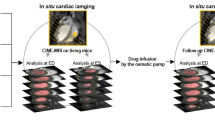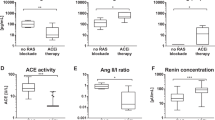Abstract
Left ventricular remodeling is a key determinant of the clinical course and outcome of systolic heart failure. The myocardial renin–angiotensin system (RAS) has been closely linked to the major maladaptive cellular and molecular changes that accompany left ventricular remodeling. Direct inhibition of various components of the RAS, such as the angiotensin-converting enzyme, angiotensin II type 1 receptor, and aldosterone, has resulted in favorable clinical responses in heart failure. Many questions, however, remain unanswered regarding the timing of initiation, optimum doses, need for simultaneous use of RAS inhibitors, and proper monitoring of RAS blockade. Additionally, significant variation has been noted in individual responses to RAS blockade as a result of genetic differences. Answering these questions requires direct access to the myocardial component of RAS, which is largely independent of its systemic component. Molecular imaging using radiotracers with high affinities for myocardial angiotensin-converting enzyme and angiotensin II type 1 receptors can provide direct access to tissue RAS and thus provide a better understanding of the pathophysiology of left ventricular remodeling in individual patients. This Article briefly reviews the potential for evaluating the tissue expression of angiotensin in heart failure by targeted RAS imaging.
Key Points
-
Left ventricular remodeling constitutes the disease process that eventually leads to symptomatic heart failure
-
The tissue renin–angiotensin system is closely linked to the myocardial cellular and molecular changes that accompany left ventricular remodeling
-
Wide variations are seen within individuals in the activity of the tissue renin–angiotensin system, mainly related to genetic factors
-
In clinical practice, the tissue renin–angiotensin system is not accessible and thus treatment of heart failure with inhibitors of this system remains largely empirical
-
Molecular imaging using radiotracers with high affinity for myocardial angiotensin converting enzyme and angiotensin-II type 1 receptor might provide an objective tool for individualizing the monitoring and treatment of left ventricular remodeling
This is a preview of subscription content, access via your institution
Access options
Subscribe to this journal
Receive 12 print issues and online access
$209.00 per year
only $17.42 per issue
Buy this article
- Purchase on Springer Link
- Instant access to full article PDF
Prices may be subject to local taxes which are calculated during checkout




Similar content being viewed by others
References
Nakao K et al. (1997) Myosin heavy chain gene expression in human heart failure. J Clin Invest 100: 2362–2370
Schaper J et al. (1991) Impairment of the myocardial ultrastructure and changes of the cytoskeleton in dilated cardiomyopathy. Circulation 83: 504–514
Beuckelmann DJ et al. (1992) Intracellular calcium handling in isolated ventricular myocytes from patients with terminal heart failure. Circulation 85: 1046–1055
Bristow MR et al. (1982) Decreased catecholamine sensitivity and beta-adrenergic-receptor density in failing human hearts. N Engl J Med 307: 205–211
Stanley WC et al. (2005) Myocardial substrate metabolism in the normal and failing heart. Physiol Rev 85: 1093–1129
Narula J et al. (1996) Apoptosis in myocytes in end-stage heart failure. N Engl J Med 335: 1182–1189
Zhu H et al. (2007) Cardiac autophagy is a maladaptive response to hemodynamic stress. J Clin Invest 117: 1782–1793
Aras O et al. (2007) The role and regulation of cardiac angiotensin-converting enzyme for noninvasive molecular imaging in heart failure. Curr Cardiol Rep 9: 150–158
Bennett SK et al. (2002) Effect of metoprolol on absolute myocardial blood flow in patients with heart failure secondary to ischemic or nonischemic cardiomyopathy. Am J Cardiol 89: 1431–1434
Bertomeu-Gonzalez V et al. (2006) Role of trimetazidine in management of ischemic cardiomyopathy. Am J Cardiol 98: 19J–24J
Giannuzzi et al. Antiremodeling effect of long-term exercise training in patients with stable chronic heart failure. Circulation 2003; 108: 554–559.
Kaneko Y et al. (2003) Cardiovascular effects of continuous positive airway pressure in patients with heart failure and obstructive sleep apnea. N Engl J Med 348: 1233–1241
St John Sutton M et al. (2006) Sustained reverse left ventricular remodeling with cardiac resynchronization at one year is a function of etiology.:quantitative Doppler echocardiographic evidence from the Multicenter Insync Randomized Clinical Evaluation (MIRACLE). Circulation 113: 266–272
Carluccio E et al. (2006) Patients with hibernating myocardium show altered left ventricular volumes and shape, which revert after revascularization: evidence that dyssynergy might directly induce cardiac remodeling. J Am Coll Cardiol 47: 969–977
Pandalai PK et al. (2006) Restoration of myocardial beta-adrenergic receptor signaling after left ventricular assist device support. J Thorac Cardiovasc Surg 131: 975–980
Klotz S et al. (2007) The impact of angiotensin-converting enzyme inhibitor therapy on the extracellular collagen matrix during left ventricular assist device support in patients with end-stage heart failure. J Am Coll Cardiol 49: 1166–1174
Braunwald E et al. (2004) Angiotensin-converting-enzyme inhibition in stable coronary artery disease. N Engl J Med 351: 2058–2068
Beta-Blocker Evaluation of Survival Trial Investigators (2001) A trial of the beta-blocker bucindolol in patients with advanced chronic heart failure. N Engl J Med 344: 1659–1667
Taylor AL et al. for the African-American Heart Failure Trial Investigators (2004) Combination of isosorbide dinitrate and hydralazine in blacks with heart failure. N Engl J Med 351: 2049–2057
Small KM et al. (2002) Synergistic polymorphisms of beta1- and alpha2C-adrenergic receptors and the risk of congestive heart failure. N Engl J Med 347: 1135–1142
Liggett SB et al. (2006) A polymorphism within a conserved beta(1)-adrenergic receptor motif alters cardiac function and beta-blocker response in human heart failure. Proc Natl Acad Sci USA 103: 11288–11293
deGoma EM et al. (2006) Emerging therapies for the management of decompensated heart failure: from bench to bedside. J Am Coll Cardiol 48: 2397–2409
Villanueva FS et al. (2007) Myocardial ischemic memory imaging with molecular echocardiography. Circulation 115: 345–352
Kaufmann BA et al. (2007) Detection of recent myocardial ischaemia by molecular imaging of P-selectin with targeted contrast echocardiography. Eur Heart J 28: 2011–2017
Paul M et al. (2006) Physiology of local renin angiotensin systems. Physiol Rev 86: 747–803
Shirani J et al. (2006) Novel imaging strategies for predicting remodeling and evolution of heart failure: targeting the Renin-Angiotensin system. Heart Fail Clin 2: 231–247
Hwang DR et al. (1991) Positron-labeled angiotensin-converting enzyme (ACE) inhibitor: fluorine-18-fluorocaptopril. Probing the ACE activity in vivo by positron emission tomography. J Nucl Med 32: 1730–1737
Lee YH et al. (2001) Synthesis of 4-[18F]fluorobenzoyllisinopril: a radioligand for angiotensin converting enzyme (ACE) imaging with positron emission tomography. J Labelled Comp Radiopharm 44: S268–S270
Dilsizian V et al. (2007) Evidence for tissue angiotensin-converting enzyme in explanted hearts of ischemic cardiomyopathy using targeted radiotracer technique. J Nucl Med 48: 182–187
Femia F et al. (2006) Synthesis and evaluation of radioligands for angiotensin converting enzyme (ACE) imaging [abstract # 1088]. J Nucl Med 47 (Suppl 1): 260P
Fyhrquist F et al. (1984) Inhibitor binding assay for angiotensin-converting enzyme. Clin Chem 30: 696–700
Matarrese M et al. (2004) 11C-Radiosynthesis and preliminary human evaluation of the disposition of the ACE inhibitor [11C]zofenoprilat. Bioorg Med Chem 12: 603–611
Mathews WB et al. (1995) Carbon-11 labeling of the potent nonpeptide angiotensin-II antagonist MK-996. J Labelled Comp Radiopharm 36: 729–737
Hamill TG et al. (1996) Development of [11C]L-159,884: a radiolabelled, nonpeptide angiotensin II antagonist that is useful for angiotensin II, AT1 receptor imaging. Appl Radiat Isot 47: 211–218
Szabo Z et al. (2001) Use of positron emission tomography to study AT1 receptor regulation in vivo. J Am Soc Nephrol 12: 1350–1358
Lee SH et al. (1999) Characterization of angiotensin II antagonism displayed by SK-1080, a novel nonpeptide AT1-receptor antagonist. J Cardiovasc Pharmacol 33: 367–374
Verjans J et al. (2005) Noninvasive imaging of myocardial angiotensin receptors in heart failure. Presented at the 25th Annual Scientific Sessions of the American Heart Association, Western States Affiliates: 2005 September 30, Irvine, CA
Kang JJ et al. (2006) Imaging the renin-angiotensin system: an important target of anti-hypertensive therapy. Adv Drug Deliv Rev 58: 824–833
Shirani J et al. (2007) Early imaging in heart failure: exploring novel molecular targets. J Nucl Cardiol 14: 100–110
Author information
Authors and Affiliations
Corresponding author
Ethics declarations
Competing interests
The authors declare no competing financial interests.
Rights and permissions
About this article
Cite this article
Shirani, J., Dilsizian, V. Imaging left ventricular remodeling: targeting the neurohumoral axis. Nat Rev Cardiol 5 (Suppl 2), S57–S62 (2008). https://doi.org/10.1038/ncpcardio1244
Received:
Accepted:
Issue Date:
DOI: https://doi.org/10.1038/ncpcardio1244
This article is cited by
-
Novel Myocardial PET/CT Receptor Imaging and Potential Therapeutic Targets
Current Cardiology Reports (2019)
-
Molecular imaging of cardiac remodelling after myocardial infarction
Basic Research in Cardiology (2018)
-
Cardiac molecular imaging to track left ventricular remodeling in heart failure
Journal of Nuclear Cardiology (2017)
-
Recent Developments in Imaging of Myocardial Angiotensin Receptors
Current Cardiovascular Imaging Reports (2014)
-
Molecular imaging in cardiovascular disease: Which methods, which diseases?
Journal of Nuclear Cardiology (2013)



